Menus
- Racing superbike for the road
- Brutal basic setting!
- Was I too weak for the Ducati Panigale R.?
- Higher, softer, faster
- Finding the perfect setup is not easy
- Great stability on the brakes and when turning
- Technical data Ducati Panigale R
- Readings
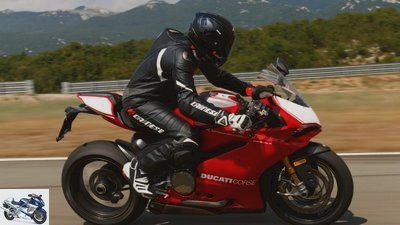
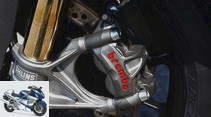
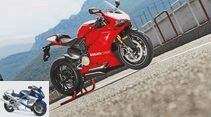
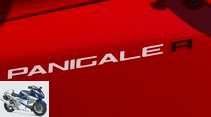
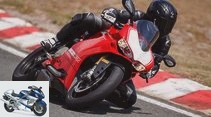
14th photos
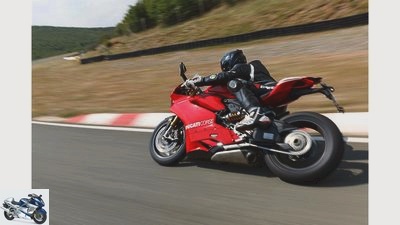
1/14
Beautiful. Noble. A technical work of art. Without frame. As usual. So single-sided swing arm mounted in the engine, steering head directly in the airbox monocoque made of cast aluminum. Finest Ohlins goods, but not semi-active. Superquadro, 1198 cc, 196 hp, 136 Nm.
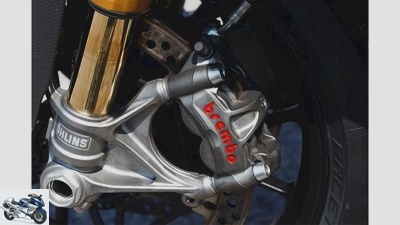
2/14
The Brembo monoblocks are a dream when it comes to controllability and bite the window like crazy.
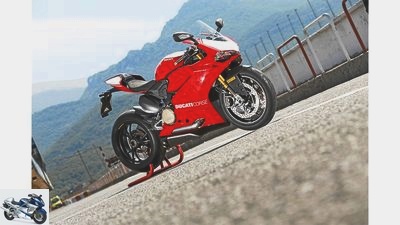
3/14
Ducati Panigale R.
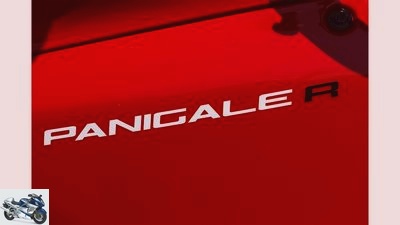
4/14
Ducati Panigale R.
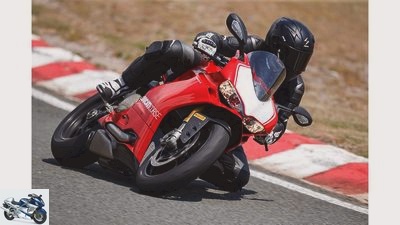
5/14
At 7400 rpm, the L2 increases by 30 (!) PS within just 600 rpm and then pours out another 80 (!) PS from 8000 to 11,000 rpm, to finally be captured by the limiter at just over 12,000 rpm to become.
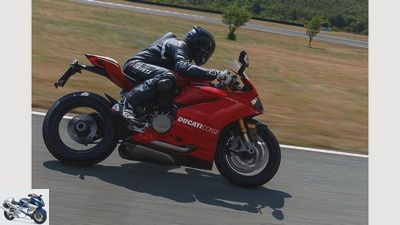
6/14
But the test bench not only attests to the engine’s enormous power and torque, but also radically sharp characteristics (see diagram at the end of the photo show).
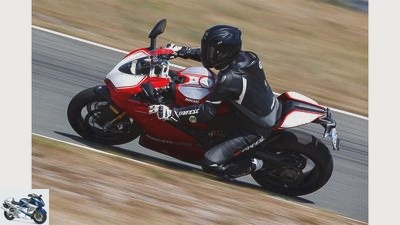
7/14
Why “only” 1198 cm³? Because Ducati is not allowed to use the big engine of the 1299 in the Superbike World Championship. The 1200 cm³ twin limit (still) applies.
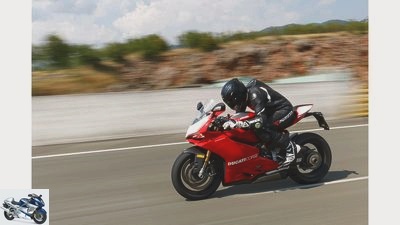
8/14
Ducati Panigale R.
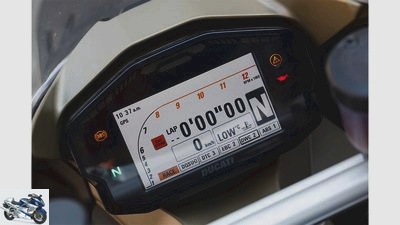
9/14
In race mode, the TFT display shows the lap time in the middle and focuses on speeds from 8000 rpm.
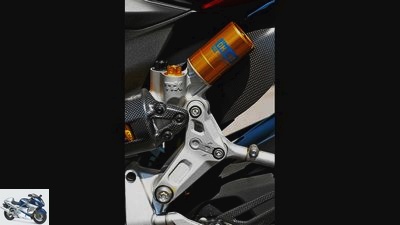
10/14
Actually intended for two-person operation, the linkage of the push strut can be set from linear to progressive.
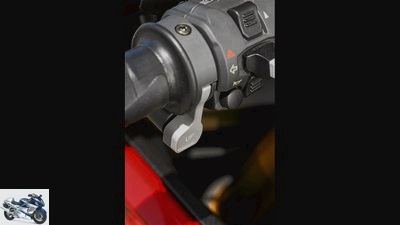
11/14
While driving, various electronic functions can be regulated at the push of a switch.
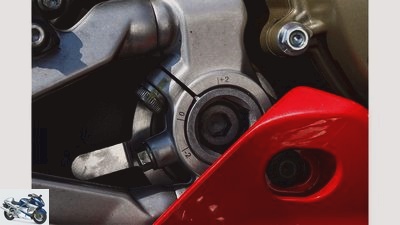
12/14
In order to get the last seconds or even tenths, the machine must be able to be optimally adapted to the respective course. One point of contact for this is the variable swing arm linkage (+ 2 / -2 / -4 mm).
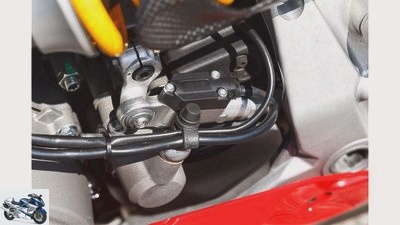
13/14
Clutching was yesterday, the blipper shifts down the gears cleanly through the gearbox.
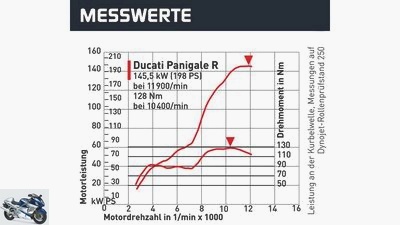
PS
14/14
Measured values of the Ducati Panigale R.
Ducati Panigale R in an individual test
Racing superbike for the road
Content of
The King of Ice Cream Parlor will whimper with hardened intervertebral discs. The King of Racing will part everyone. The Ducati Panigale R is shockingly serious in the individual test on the racetrack in Rijeka.
Rijeka. 38 degrees in the shade. On the not exactly board-level racetrack with the notoriously rough asphalt, three heat-resistant locals cavorted with loudly roaring thousands – and we. But while we’re still the D.Unloading ucati Panigale R, the rag collector drove for the first time. There were only two left. Our on-site contact stated factually: “Facebook driver. They have no idea. They come and fall. Is a new trend. “
Buy complete article
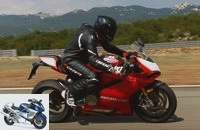
Ducati Panigale R in an individual test
Racing superbike for the road
To explore Panigale R, I’m just too slow. In the area in which Ducati’s new, approved racing superbike shows its true strengths and separates the wheat from the chaff, someone like me hardly makes any progress. But the fact that the R almost demoted me to a “Facebook driver” and shook me deeply in the first few laps was surprising.
Brutal basic setting!
There she was. Beautiful. Noble. A technical work of art. Without frame. As usual. So single-sided swing arm mounted in the engine, steering head directly in the airbox monocoque made of cast aluminum. Finest Ohlins goods, but not semi-active. Superquadro, 1198 cc, 196 hp, 136 Nm. Why “only” 1198 cm³? Because Ducati is not allowed to use the big engine of the 1299 in the Superbike World Championship. The 1200 cm³ twin limit (still) applies. As I rolled onto the track, I expected an inferno. No other production machine is as close to the Superbike World Championship as this Ducati Panigale R..
After the test bench had attested not only an enormous amount of power and torque to the engine, but also a radically sharp characteristic, I braced myself for the proverbial blow on the back of the head. I was convinced that the most bloodcurdling experience on the Ducati Panigale R would take place precisely when the Superquadro was in the correct speed range. At 7400 rpm, the L2 increases by 30 (!) PS within just 600 rpm and then pours out another 80 (!) PS from 8000 to 11,000 rpm, to finally be captured by the limiter at just over 12,000 rpm to become. Just under 200 hp. In addition, one can add here: From 7200 to 8500 rpm the torque “explodes” from 85 to 120 Nm! madness!
Ducati Panigale R.
The times of the linear testastretta with the potent middle are long gone. And yet it wasn’t the crazy Superquadro that drove me desperately into the pits after a few laps, but the chassis of the Ducati Panigale R. To hell, what was going on? Race-oriented Ducatis have always been tight, but that the machine bucked so much that I lost contact with the saddle, that has never happened before.
What a brutal basic setting! Divine feedback, killer traction, super-precise control of the head? Not even close. None of that was there. As soon as the asphalt wasn’t super slippery, there was air under the tires. In the quick right turn on the home straight it was so bad that I had trouble keeping contact with the Ducati Panigale R. It shook me back and forth. Full throttle? Impossible!
Was I too weak for the Ducati Panigale R.?
Of course you get doubts. And of course you don’t look for the fault in the machine, which you know is a fast and powerful racing Ducati following a long tradition, but in yourself. Was I too weak for the Ducati Panigale R? Does it only work properly if you move it much faster? Kelle waves aside: “You can’t drive fast laps here with the setup. Too often you lose ground contact and control. I haven’t seen that before. ”That calmed me down.
On the one hand. On the other hand, we now had to invest a lot of time to find a chassis set-up that was obviously tailored by Ducati for a track with flawless asphalt à la Monza, for the sometimes bumpy Rijeka. And that’s not child’s play with the Ducati Panigale R. Because not only are the dampers adjustable in preload, rebound and compression, but the linkage and length of the strut can also be varied. A disaster for a normal racer like me.
There are just too many free parameters. Of course, these opportunities for racing at World Championship level are great, because with enough expertise and experience you can adjust the machine perfectly to each track and find a setup that is ideal for the decisive battle for the last second or the last tenths, but In journalistic test operations, where you rarely have more than a day, it’s a challenge. Especially when the basic setup – like here in Rijeka – doesn’t work at all. Why Ducati offers such a system of spatial diversity for the shock absorber is probably due to the fact that racing teams cannot change anything on the Panigale frame, because there is no longer any. You can’t make it stiffer or more flexible.
Higher, softer, faster
We drove out, we drove in. And adjusted. Until we had a setup that didn’t work perfectly, but was worlds better than the basic set-up and allowed us to fire the brute Ducati Panigale R somewhat unleashed. With the slightly higher rear end and the much softer damping, I could guess what the Panigale R would do with its opponents in the right hands. Not every corner entry on the brake (which is simply fantastic in terms of control and bite) was ideal because I still didn’t quite have the feeling that I could feel the front wheel one hundred percent, but compared to the first laps that was a lot smooth. Meanwhile, I was also very satisfied with the steering behavior, only in turn 2 there was an irritation. A small bump in the asphalt at the turn-in point made the machine stiff and remained stubborn for what felt like a meter.
Firing after the apex was tricky for me until the end. It wasn’t the crazy engine power at all – it is actually unbelievably impressive how crazy the Superquadro breaks the chain in the right band! – the problem, but the still not crystal clear transparency on the rear wheel of the Ducati Panigale R and the not yet completely resolved loss of contact with the ground. With traction control at level 3, I sometimes had slides that made me push. But, and that was the decisive factor for me: In contrast to the first turn, I was now able to pull thrill-filled laps with the dramatically changed setup and work through the route section by section. It just got better. That would have been a lot easier for me on any modern four-cylinder superbike. Then came Kelle.
Finding the perfect setup is not easy
Kelle had already done a few fast laps with a Yamaha YZF-R1M, which worked very well in the standard setup in Rijeka, and now believed he was two or three seconds slower with the Ducati Panigale R: “To the Ducati on the rough To coordinate the undulating course very well here, we would need more time. We might have to work with other springs as well. Finding the perfect setup is not always easy, but it is incredibly important in racing. Only if the machine is set up in such a way that the driver develops one hundred percent confidence can the package be victorious. That is also the big difference between racing and test driving. In racing you have a machine that is completely tailored to you, in test driving you don’t. ”
I wanted to know: “And if you light up the Ducati Panigale R now, will you just drive over the area where it still buckes and lurches over it?” Kelle: “No. If it was about the World Championship, I would probably do that, but as a test driver it would make no sense. It’s more about showing the readers how the machine works. A fall would destroy a lot of work. ”Then he drove out. I hurried to the stands and watched Kelle and the Panigale R as they destroyed the dream of the four-cylinder.
Great stability on the brakes and when turning
Kelle came back in after four laps. He looked drawn: “Exhausting. You really have to fight with it. The setup is still far from ideal, but with the new tires there was a lot less unrest when accelerating after the crown, and the stability on the brakes and turning was great. If we had a little more time, we would be able to position the machine so that it is on the R1M. ”Kelle believed that he would have been a second or two slower with the Ducati Panigale R. In fact, however, the “strenuous” Duc was a few tenths ahead! Splendid!
Why do I like it when I prefer to be out and about with a four-cylinder grenade myself? Because Ducati has been building uncompromising racing machines for decades, which can even be approved as R models. Ducati already represented this unconditional racing approach when all the other manufacturers were still selling “softened” superbikes that had to be modified if you wanted to drive fast laps with them. The Ducati Panigale R raises the bar again. You can see that in the unrivaled low weight: 188 kilograms with a full tank!
Technical data Ducati Panigale R
Why “only” 1198 cm³? Because Ducati is not allowed to use the big engine of the 1299 in the Superbike World Championship. The 1200 cm³ twin limit (still) applies.
Readings
PS
Performance measurements.
Pressure in the middle is no longer the creed of Ducati Superbikes. The power gathers mainly above 8000 rpm.
Related articles
-
Ducati Scrambler Icon in the PS performance test
andreasriedmann.at 18 pictures andreasriedmann.at 1/18 Ducati Scrambler Icon in the PS performance test. andreasriedmann.at 2/18 Ducati Scrambler Icon in …
-
Ducati 959 Panigale and MV Agusta F3 800 RC in comparison test
28 photos 1/28 The two beautiful Italian racers Ducati 959 Panigale and MV Agusta F3 800 RC in a comparison test. …
-
Ducati Panigale V4 25 Anniversario 916 – special anniversary model
Motorcycle fair in Milan EICMA 2019 Presented by Ducati 15 images Ducati 1/15 Ducati has launched a new special model in honor of the legendary 916 …
-
Ducati 1299 Panigale S and Kawasaki Ninja H2 in comparison test
31 photos 1/31 On the left in the picture 197 PS and 145 Nm (Ducati 1299 Panigale S), on the right there are 200 PS and 133 Nm…
-
Test: BMW S 1000 RR against HP4 and Ducati 1199 Panigale against Panigale S.
30th photos 1/30 The top super athletes from BMW (HP4 and S 1000 RR) and Ducati (1199 Panigale / S) in the large MOTORRAD group…
-
Husqvarna, Ducati and Aprilia Supermotos in the test
22nd photos 1/22 The three fun bikes: Husqvarna Nuda 900, Duacti Hypermotard 1100 Evo and Aprilia SMV 750 Dorsoduro – in a…
-
Test naked bikes Aprilia, Benelli, Ducati, Kawasaki, KTM, Suzuki and Yamaha
Naked bikes from Aprilia, Benelli, Ducati, Kawasaki, KTM, Suzuki and Yamaha Seven naked bikes in a comparison test Content of Naked bikes…
-
Ducati 1199 Panigale S in the top test
15th photos 1/15 Grim look: LED headlights are being used for the first time in a motorcycle. 2/15 Ducati 1199…
-
Comparison test Ducati 900 SS against Honda VTR 1000 against Laverda 750 S Formula
Comparison test Ducati 900 SS against Honda VTR 1000 against Laverda 750 S Formula Who dares, who twint Brand new and already in the large comparison…
-
Top test: Ducati Multistrada 1200 S Touring
28 photos 1/28 In a total of four speed levels – Sport, Touring, Urban and Enduro – bits and bytes vary the chassis and engine…